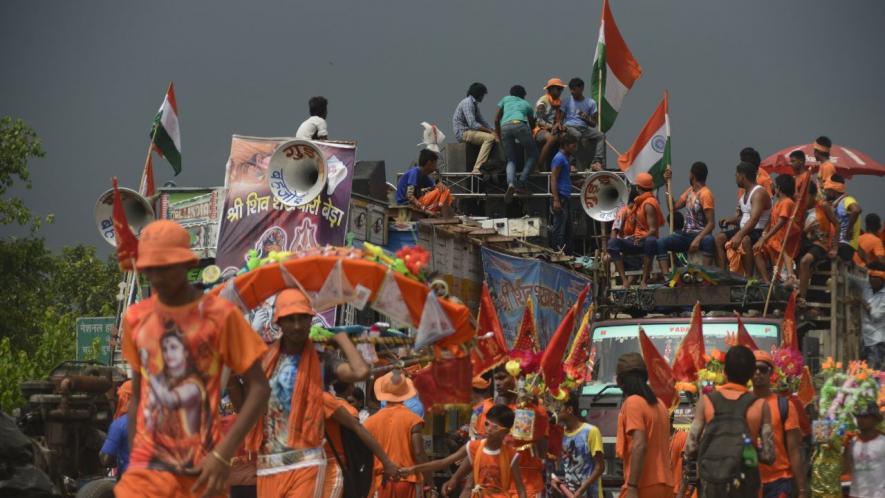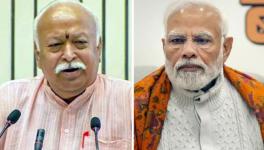Grand Kanwar Yatra Scheme of Majoritarian India

Image by Sreedeep Bhattacharya
It is a high-decibel war out there, and it continues for weeks at this time of the year. It consists of a great deal of paraphernalia and a unique mob mentality. It has processions, which move slowly, dragging their props on wheels. All of it is a legit sign of the increasing presence of Hindu religiosity in public spaces.
We’re talking about the saffron-clad parades, not only the ones that proceed from place to place every monsoon innocently fetching holy water but the ones that brag about their religiosity as they wend their way.
The latter are not naïve processions but public spectacles with boorish on-the-move displays that misappropriate public spaces. Their only wish is to announce the existence of a Hindu nation as loudly as possible. The most potent weapon in their armoury is not derived from religious symbolism. For that, the foot soldiers of Hindu Rashtra boast an assemblage of gigantic speakers.
Very high on josh, their motto is simple—who is the loudest of us all? After all, Baby ko bass pasand hai—Girls love low-pitched sounds. For that reason, devotional melodies are the last thing on their playlists.
In a country that is officially still secular and where every religious denomination has the right to pray and organise processions, you would wonder, what is the problem with the kanwar yatras?
In that case, why do those who get extremely disturbed by loud calls for azaan near us have no issue with bass-heavy blasts that send shivers and shocks across streets and rattle our windows? Because that is how it is meant to be: a base assertion by just one of the country’s religious communities, expressed through displays of unconcern for anybody else who may need to use public spaces.
And why not, when the State has permitted, even reserved several lanes of premiere highways to facilitate these monsoon religious processions, no matter the inconvenience to the general public?
That is why these all-encompassing processions go beyond roads and sounds. Unsurprisingly, Hindu temples have proliferated in the unlikeliest places, including police stations, over the last decade. It is also unsurprising how the Congress and several regional parties have taken recourse to invoking Hindu religious symbolism before and after elections through temple visits and public recitals of Hindu chants. A couple of months ago, saffron-clad sadhus populated the inauguration of a new parliament building. There is no room for doubting how deeply enmeshed our politics is with religion.
Dressed in saffron, draped in the tricolour, there is nothing sacrificial about the long march of kanwar yatris either. Each of their bodies represents a country in the process of becoming the nation the majority aspires for. Their rowdy body language and sense of entitlement is an extravaganza that comes to populate the public space.
Their activities in their overloaded trucks and bikes have more to do with entertainment than religion, and they are a nuisance. They make merry without a care, but anything in their way is at risk. Citizens are expected to come to terms with it silently and suffer the slow traffic and aggressive celebrations. They must bear this hardship in the name of religion, which increasingly ceases to be private.
Tattoos, sunglasses, baseball bats, heavy bass—everything goes. All is cool. So is banging, beating or thrashing anything in their way. Our crudest consumerist exhibition does not make us civil—caring for other citizens does. Can we expect the values of citizenship from what looks like hooliganism?
Tolerance is a rare virtue, except when we citizens are expected to tolerate a great deal of adversity—the abrupt demonetisation of currencies, sudden lockdowns, Pegasus-level surveillance, Enforcement Directorate raids, etc.
Barring the objective of the journey, nothing appears overtly religious about kanwar yatras any longer. But they have the sanction and support of not just the State but manufactured public sentiment. When places of worship can be demolished, and people can be lynched in public, a little bit of public inconvenience seems a rather insignificant part of our lived experiences.
So what if the highway traffic slows to a crawl? So what if we wait a little longer? So what if we are diverted through faraway routes and burn some extra fuel? So what if we turn deaf with the loudness of gigantic woofers? So what if we consider these crass caravans utterly divorced from expressions of faith?
After all, we are not being made to witness ordinary rituals but a nation on the move, on a mission to occupy not just public spaces and the public imagination with a populist-majoritarian ethos.
The author is a sociologist with the Shiv Nadar University and author of Consumerist Encounters: Flirting with Things and Images. The views are personal.
Get the latest reports & analysis with people's perspective on Protests, movements & deep analytical videos, discussions of the current affairs in your Telegram app. Subscribe to NewsClick's Telegram channel & get Real-Time updates on stories, as they get published on our website.
























